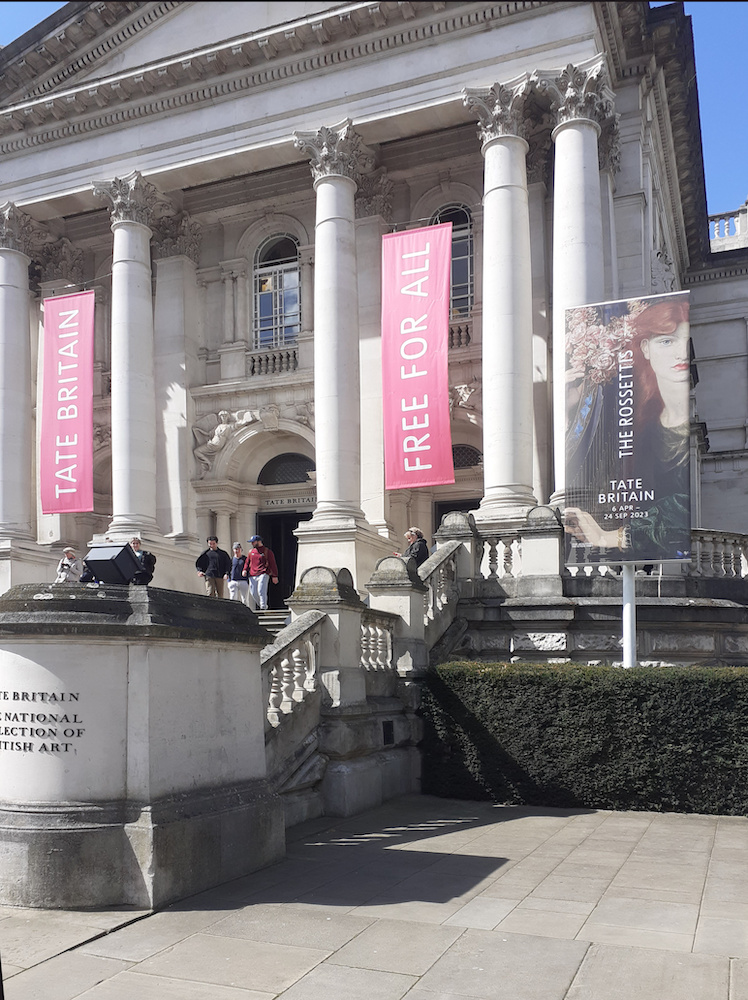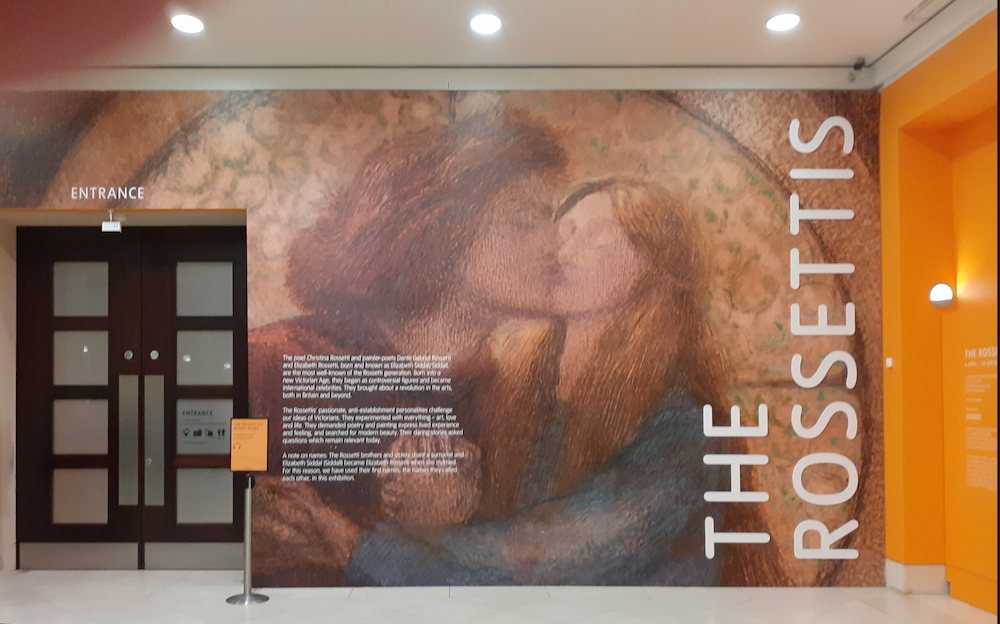

The outside of the Tate and the entrance to the exhibition. Photographs by the reviewer. Click on all the images to enlarge them, and usually for more information about them.
Currently being held at Tate Britain, London, The Rossettis, Radical Romantics is a large, engaging and sometimes controversial show. Its aim is to consider the importance of the family as a whole, focusing on the work of the four siblings, Dante, Christina, William Michael and Maria. The keynote is sounded in the opening exhibit, Ecce Ancilla Domini! (1849). Painted by Dante, it represents William as the Angel Gabriel and Christina as Mary: in effect, three Rossettis in one, and each engaged in producing a work of art. That shared artistic impulse is traced throughout the show in a dazzling array of artefacts – paintings, drawings, manuscript poems, photographs, woodblock illustrations, book bindings, rare issues of The Germ, wallpaper, and furniture. The scope is ambitious, and it naturally extends to include a Rossetti by marriage, Elizabeth Siddal.

Dante Gabriel Rossetti's Ecce Ancilla Domini! (1849). Photograph by the reviewer.
Several aspects are cleverly drawn out. First and foremost, the curators stress the Rossettis’ literariness as a family immersed in the worlds of English and Italian literature. The opening room, entitled simply “Poet,” displays extracts from Christina’s verse, accompanied by recorded readings of her verse. Also on show is Dante’s manuscript of “The Blessed Damozel,” and we are constantly reminded not only of the literary orientation but of the free interchange between art and poetry. Most of Dante’s and Lizzie’s images were inspired by poems and his large canvases, paired with the artist’s sonnets, are reproduced in wall-lettering; at the same time, Christina’s verse employed a vivid imagery which emulated the effects of visual art and was considered “word-painting.” These intermedial, “double works of art” are the backbone of the show, and stress how much the Rossettis’ work moved freely across the media.
Formally linked, their texts in words and lines are likewise related by thematic unities, notably the obsession with Dante Aligheri and the overwhelming focus on loss, yearning and melancholy reflectiveness and grieving. Christina and Dante were artists and writers of love, but they were rarely celebratory. Nevertheless, there is a distinct erotic charge to “Goblin Market” and in the reflections on prostitution represented by Dante’s poem “Jenny,” by his paintings Found and Bocca Bocciata and, above all else, by the strange and haunting Beata Beatrix, Lizzie “rapt from earth to heaven” in a pose Evelyn Waugh thought pornographic. Sex as romance, sex as threat, sex as objectification, sex as suffering, sex as death, sex as power, sex as taboo: these obsessions run through the show, and are well drawn out in a series of careful selections.



Three of the Rossetti paintings featured here. Left to right: (a) Found (begun 1853 or 1859). (b) Bocca Bocciata (1859). (c) Beata Beatrix (1864-70). These and the following images come from our own website.
This sharing of themes positions Dante and his sister as practitioners of Victorian Romanticism: it is fascinating, and worth pondering. But the most interesting aspect of the show, at least for me, was the room entitled “Modern Medievalists.” In this revisionary display, the curators explore the symbiotic relationship between Lizzie and Dante, charting an intimacy turned into art with Lizzie re-viewed not as the minor partner, but as an original artist whose drawings had a significant influence on her husband’s work as he assimilated and sometimes appropriated her ideas, and she in turn absorbed his. This interchange is illustrated by the couple’s entrancing medievalist paintings and drawings of the 1850s. These fervid, febrile images offer a cramped, gawky, tender and ultimately quite troubling collaborative vision, in part expressionism and in part a sort of archaic dream-world, courtly love as a symbol of the partners’ emotional and sexual relationship.
Such intermingling of art and life is a central concern, and we never lose sight of the fact that the Rossettis’ biographies deeply inform their creative productions. The story of Dante’s development is shown to be largely the reflection of his relationship with Lizzie – at least before her place was taken by Fanny Cornforth and Jane Morris. The exhibition remarkably displays a couple of deeply personal artefacts, some locks of Lizzie’s hair, and a manuscript page from the poem “The Portrait,” a sheet (supposedly) one of those Dante infamously retrieved from her coffin. The objects make us think of the painter-poet’s motivations: is this an act of simple selfishness, of love – thinking Lizzie would want him to publish, as his muse hardened into an abstraction – or is it grotesque morbidity, the ultimate commodification of the female body, stripped of all dignity? The viewer is encouraged to reflect, and with that in mind it is difficult to shake the image of a desecrated grave as we consider the artist’s luxurious, large-scale pictures of the 1860s and 70s, Lilith, The Beloved,Mnemosyne and Proserpine.



Three more of the Rossetti paintings in the exhibition. Left to right: (a) Lady Lillith (1866-68; 1872-73). (b) The Beloved (1863). Proserpine (1874).
By now the Adored One has mutated into a femme fatale or an ambiguous cipher, and by placing the canvases together the curators point to the weird obsessiveness of Dante’s later work as it morphed into Aestheticism and then into an oppressive Symbolism. It is a considerable journey from the fresh-faced characters in Ecce Ancilla Domine, to the troubling portrait of an abstracted Janey Morris in Mnemosyne, a version of Manchester’s Astarte Syriaca. What started as a poetic take on the purity of Quattrocento art turns into a particular sort of nightmare as the drug-raddled painter lost his mind: innocence turned experience, as in the poetry of Blake, which Dante so admired and studied in a notebook he acquired from the British Museum.
This progression is well-charted, offering a cogent interpretation. However, it is important to note the exhibition’s weaknesses too. One is the emphasis on political interpretations, with accusations of racism which are not well supported and anachronistic in tone, even if the charge of misogyny is pretty much undeniable. Yet the show’s primary weakness is its denial of the very inclusiveness it projects as its novel pitch. It claims to explore the impact of the Rossettis as a whole, rather than the usual focus on Dante, and it starts well, mentioning Rossetti senior as an interpreter of Italian literature and William Michael as an art and literary critic; but William’s role as the Pre-Raphaelites’ and family’s prime chronicler, without whom much less would be known, is only given lip-service. There is no mention of his writing as a poet, while Maria, the author of A Shadow of Dante, does not feature at all. In short, The Rossettis is not faithful to its brief but ultimately a triangulation of just three talents: Dante, Lizzie, and Christina. The others might as well not have been there at all. Indeed, Dante’s presence is so overpowering that by the end Christina and Lizzie have also faded, as if his massive creativity had rendered them into ghosts, accessories to his notion of beauty. The Rossettis’ show becomes once again the Dante Rossetti show.
It is still a hugely enjoyable event, richly illustrated, cleverly organized in its division into sections, supported with insightful commentaries and undoubtedly persuasive: the central figures were radical romantics, working to expand the languages of Victorian art and poetry and endow them with deep feeling. In the twenty-first century, the age of virtual reality and the bland commodification of practically all aspects of life, a curious and troubled family from the mid-nineteenth century shows us how to burn, Pater-like, with a hard, gemlike flame.
Created 17 April 2023